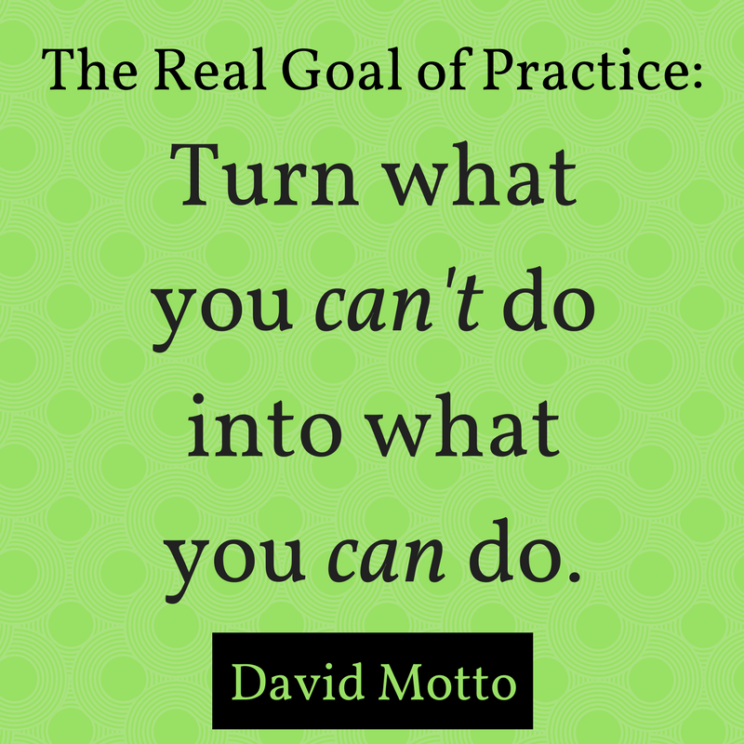David Motto’s Practice Tip of the Week:
Tough Stuff
What is “Tough Stuff”?
In every song or piece you want to learn, there is inevitably one section that seems too high, too fast, or too hard. Sometimes there are many of these sections.
This is the music most of us want to avoid! Depending on the genre of music you play, you’ve probably heard these sections called “hard licks” or “difficult passages.” My favorite term for this music is “Tough Stuff.”
Finding the Tough Stuff in every song you learn is one of your most important tasks. Once you find it, you’ll need a process to deal with it, own it, and turn it into something you fully control.
That process is the focus of this week’s Practice Tip.
STEP 1: Find the Tough Stuff
As much as we would like to spend our practice time going< over everything we already do well, real growth comes from learning new skills. You'll get new skills primarily by mastering the Tough Stuff.
This means that every time you come across something specific in a song that you can’t play (or that slows you down or makes you nervous), stop what you’re doing and make a note of it. You’ll keep a list of these specific areas that will need your focus. The list can be in writing, or you can circle the areas in your sheet music.
The contents of this list will become the focus of your practicing.
STEP 2: Let Go of Unsuccessful Practice Methods

Most musicians avoid the Tough Stuff by using the “Top to Bottom” method of practicing. This practice method is really pretty simple: You play through entire songs – always from start to finish – but never really master them.
This method is unsuccessful, and using the Top to Bottom method leads to musicians’ never figuring out what exactly is causing their difficulties and never learning their music thoroughly.
Sure, you’ll feel like you’re getting better. But, on every runthrough the Tough Stuff will slow you down or force you to restart. After a while, you won’t even notice that some of the notes (usually the same ones every time) sound a lot worse than everything else. You’ll get used to playing the Tough Stuff badly. Or, you’ll just get frustrated and wonder why this song is so hard.
One thing you won’t do using this unsuccessful method is take the time to actually make a list of the Tough Stuff – a list that could move you in a new, positive direction.
STEP 3: Reorganize Your Practice Sessions
So, how does this list of Tough Stuff impact your practice sessions? Essentially, you’ll want to spend at least half of your practice time on the Tough Stuff.
For many musicians this means rethinking your concept of what practice sessions are. Solving the puzzles hidden inside of Tough Stuff doesn’t seem like a “normal” practice session if you’re used to playing songs top to bottom all the time.
I’m not saying that all you should do is practice Tough Stuff. Don’t eliminate your warmups and technical exercises (which can have Tough Stuff of their own). And, keep reviewing songs you already know how to play by doing runthroughs of them. Just make sure the bulk of your practice time is spent mastering the new and difficult – which is now on your list.
STEP 4: Deal Directly with the Tough Stuff
Now that you’ve given yourself time to work on the most difficult sections of your songs, here are some ideas you can use to take full control of the Tough Stuff – so it will no longer be so tough to play:
- Learn just the pitches, without worrying about the rhythm.
- Figure out just the rhythm, without worrying about the pitches.
- Play very, very slowly. (Much slower than you think you should!)
- Play the first 2 notes, then the first 3 notes, then the first 4 notes. Keep building, note by note.
- Play just the last note. Then, the last 2 notes. Then, the last 3 notes. Eventually, you’ll be playing from the first note to the last note of this section.
- Sing through the section to make sure you fully understand how it’s supposed to sound.
Your New Practice Goal
The four steps above give you specific strategies to build success when you practice the Tough Stuff.
Focusing on the Tough Stuff may take a rethinking of your use of practice time. Fortunately, this focus will improve your technique, give you confidence, and help your performances.
Instead of practicing what is comfortable, you’ll have a new practice goal:
Turn what you can’t do into what you can do.
This is exactly what will happen when you focus on the Tough Stuff.
To Your Musical Success!David Motto

Great ideas! I will try these. Thanks, David.